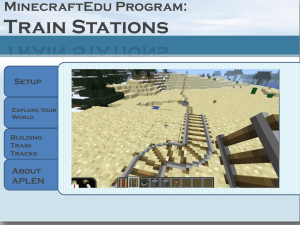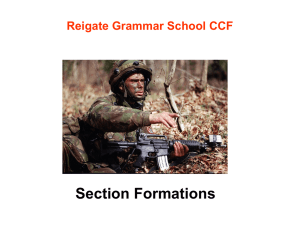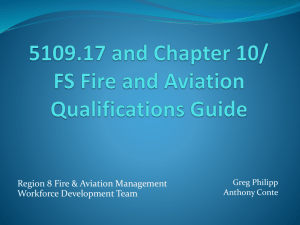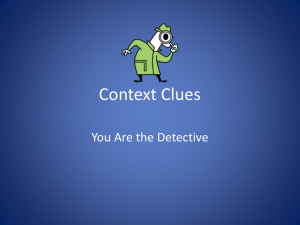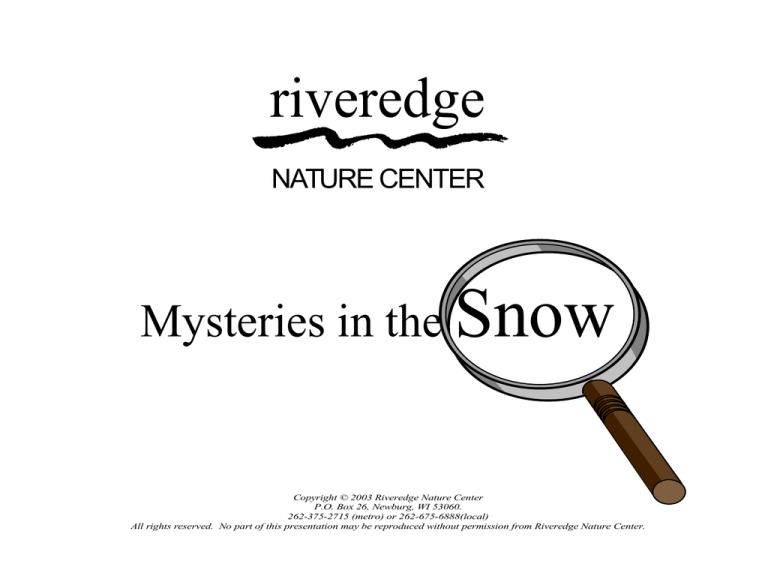
riveredge
NATURE CENTER
Mysteries in the Snow
Copyright © 2003 Riveredge Nature Center
P.O. Box 26, Newburg, WI 53060.
262-375-2715 (metro) or 262-675-6888(local)
All rights reserved. No part of this presentation may be reproduced without permission from Riveredge Nature Center.
Playing an instrument...
taking pictures, and
drawing are all skills that take time,
patience, and practice to develop.
Observing is also
a skill that takes
time, patience
and practice to
develop.
It requires the careful use of all your
senses: sight, hearing, taste, touch, and
smell.
Once you have observed carefully you
should be able to form an inference, a
conclusion about what might have
happened.
To do this you will need to add your
thinking ability and your observation skills
together.
What did you just observe?
What season was it?
Were there leaves on the trees?
What habitat was shown?
What animal did you see?
Was the animal big or small?
Was the animal on the ground or in a tree?
Was the animal standing or sitting?
Look again.
What things can you observe
now that you have more time?
The next slide will again test
your skills of observation.
What did you observe?
What animal was in the tree?
What color was the animal?
Was the tree dead or alive?
Is there only one animal who has been
using that tree?
Here it is again.
What else can you observe?
Planning for your visit to
Riveredge and the time you
spend there will help increase
your observational skills and
your ability to draw conclusions
from what you see.
A detective has the job of carefully observing
clues to solve mysteries.
Two important
characteristics of
detectives are patience
and the ability to
observe very carefully.
To solve a mystery they
need to carefully observe the clues and then
use these clues to develop a solution or form a
good inference.
Inferences are an
explanation of events
based on careful observation.
Use what you observe in the
next slide to develop
explanations (inferences) for
the mysteries that are
presented.
You will need to use your brain
power to arrive at the
solutions.
Look and think, do not guess!
What can you observe
in this slide?
Using your observation skill, what do
you think made the tracks on the hill?
What winter “sports” can you think of?
From your careful observations what
more can you say about this picture?
What inferences can you make?
What winter “sport” could leave this
pattern of tracks behind?
Are the tracks made from one or two
skiers?
(Two)
Which person used the hill first? The
person going up or the person coming
down?
(The straight track goes over the “V”
track--so the person going up the hill
was first.)
As a detective “on the trail” at Riveredge you need to know
what types of clues to look for. There are an endless number
of mysteries to be solved. The pieces of the story left on the
landscape are there for you to puzzle out. What types of clues
will you look for at Riveredge to explain what animals are
active during the winter and what they are doing?
Tracks are some of your best clues.
Tracks can take you places or...
...be a hint of where you were.
Tracks are an animal’s signature on the land.
When you are looking at a track notice its size and shape. Look
for toes, toenails, and possibly for marks left in the snow by the
animal’s tail. Try to imagine the size of the animal that made the
tracks.
Describe the shape of this
track.
How many toes does it have?
(Four)
Can you observe any toenails?
Which direction was this
animal moving?
(Towards the top of the page)
How do you know?
Animals do not often leave behind
clear, easily identifiable tracks.
It is important to look at
the pattern of tracks that
form the trail in order to
identify the source of the
track. Animals are not
eager to use lots of
energy, so most of the
time they walk or shuffle
about. Most of the tracks
you find will be at the
animal’s slowest gait.
Remember, the track
patterns change as the
animal’s activities change.
There are three general
track patterns to look for.
Walkers, whose
tracks often
appear in a single
line...
...such as a fox.
Who do you think made these tracks?
A Duck?
Actually, it is made by a gull.
Can these gull tracks help you think of one word to describe
how this animal moves?
We use the word--Waddles
A second track
pattern is waddler.
Waddlers, whose
tracks often appear
with one front foot
and one hind foot
paired together...
...such as a raccoon.
Bounders create yet another track pattern. Their
tracks appear as a repeated set (in pairs)...
...such as a
rabbit.
An animal’s body structure, its method of gathering food, and
its behavior will determine its pattern of movement and the
resulting tracks.
Describe these tracks.
Describe their shape.
How many fingers/toes are
there?
(There are Five toes. )
Are toenail marks visible
in the track?
Based on your
observations, are these
tracks from the front or
hind feet?
Can you see where the animal’s toes are?
The toes “point” out the direction the animal was traveling.
Which direction was this animal traveling?
The animal was traveling towards the bottom of the page.
Is this animal a walker, bounder, or a waddler?
It is a Waddler.
What might have
made these tracks?
It is a Raccoon.
The waddler itself. This raccoon’s body is
chunky and low to the ground. Would it be good
at stalking its prey-- like a fox?
Notice the general pattern
created by these tracks.
From your observations is
this animal a walker?
A bounder?
Or a waddler?
These tracks may be
familiar to you. Do you
have enough information
from your observations to
make an inference as to who
might have made the tracks?
Hint: This animal cautiously
stalks its prey. It feeds on
both plants and animals.
This is the
animal that
made the
tracks.
How many feet does this animal
have?
(Four.)
Can you notice any toenail marks
visible in the track?
Which set of feet are smaller?
(Their front feet are the smaller
ones.)
Why do you think the back feet
tracks are above the front feet
tracks?
Which direction is it traveling?
(Towards the right side of the
screen.)
Is this woodland animal a walker? A bounder? Or a waddler?
It is a bounder.
This trail was made by the
same animal.
Where does it begin?
Where does it end?
What could have happened to
the animal that made the trail?
What animals are climb trees?
Who do you think made this
trail?
Yes, it is a squirrel!
Tracks can lead you to more
clues to the mystery.
Many animals can be easily
identified by the clues they
leave behind.
Animals are adapted with
special tools to construct
their homes.
The size, shape, and location
of the home are some of the
clues that help us infer what
particular animal made the
home.
What was the shape of the animal home you
just saw?
How big was it?
Where was it located?
How high was it?
What animals could use the hole in the tree as
a home?
What special tool does this
animal have to make that
hole in the tree?
What other tools does it
have that are also clues that
the home belongs to the
woodpecker?
How did it get to the tree?
How does it stay on or in
the tree?
What made this pattern in the snow?
Is the animal underground or above ground?
(It is Underground)
What size do you think the animal is?
Who do you think made the pattern in the snow?
Does this help you?
Evidence of animal homes and shelters are good
clues to identify the type of animal.
Every piece of gnawed vegetation is a clue left by an animal feeding.
What can you infer about the animal
or animals that were eating here?
They are hungry.
This sapling is a good source of food. This animal’s teeth are specially
designed to eat this type of food source.
Animal scat, the waste products that result after an animal digests
its food, is a clue that can help you determine what animals are
living.Bits of its food may still remain in the scat as a clue of what
was for lunch. This is deer scat.
You are now beginning to develop an eye for seeing - really seeing.
Practice observing, then practice some more, and then practice even
more. Examine all the clues carefully before drawing your conclusions.
To truly test your abilities see if you can solve these last mysteries.
Whose eye is this?
It is an Owls.
What happened here?...what else
occurred?
The maker herself.
Make an inference as to how the backsides of the individuals
sitting on the benches must have felt during their program.
What made these tracks?
What was the sequence of events as shown in the slide?
What was the vehicle’s path of travel?
There are two other sets of tracks in this picture. Do you see them?
You have already seen the animal(s) in previous slides. Do you
know who made these tracks. One set of tracks was made by a fox
and the other by a rabbit. Which animal made which set of tracks?
What happened here? Who left
their tracks behind?
Who are the two animals involved in this
mystery? Who made dinner out of whom?
Congratulations!
You are now ready to discover the mysteries found at Riveredge Nature Center.
But there is one more very important thing to consider. Dress warmly for your visit.
We will be outside the entire time! You will need to wear lots of clothes.
What pieces of outer clothing are the children in this picture missing?
You’ll need a whole pile of clothes just as you see here. Dressing in layers is a
good idea. This traps air which will keep you warmer. Often it is better to dress
in 3 thinner layers of clothing than one thick layer. The layers of air trapped by
those clothes and warmed by your body will insulate you from the cold.
Do not forget long
underwear.
Flannel pajamas are a good
substitute if you do not
have any of your own.
A couple pairs of socks
inside of your boots are
important also.
Leave your tennis shoes at
home!
Remember, layers are important!!
Remember your observation skills!!
Hat on your head and mittens on your hands, and you are ready to go!
See you at Riveredge!


